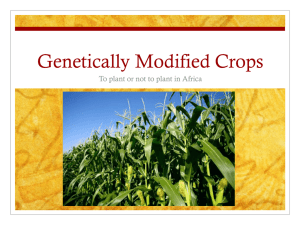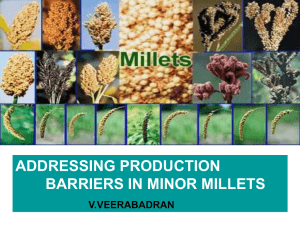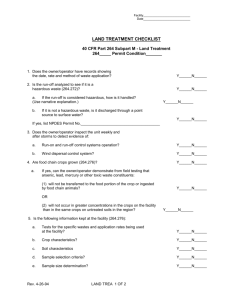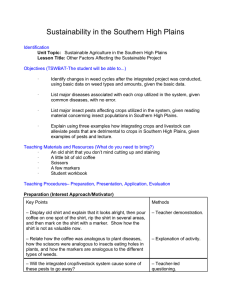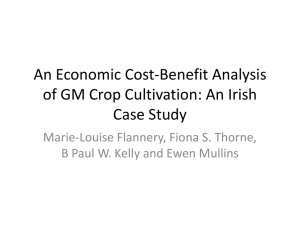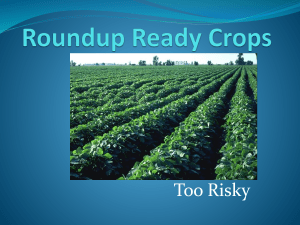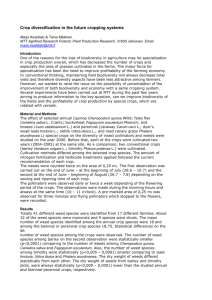IMPACTs OF CLIMATE CHANGE
advertisement
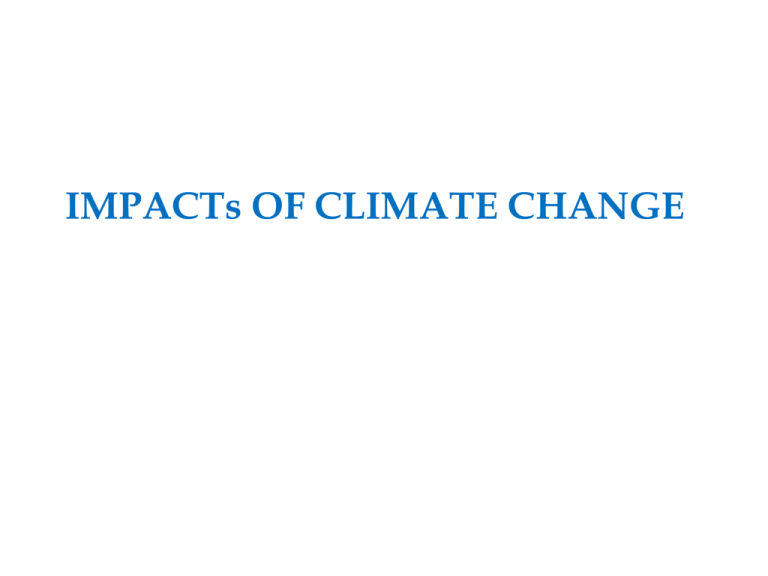
IMPACTs OF CLIMATE CHANGE Senstivity of growth in Scots pine (left) and Norway spruce (right) in different parts of the Baltic Sea basin compiled from the findings of SilviStrat project (Lindner et al. 2005). Rovaniemi - the northern boreal forest Kuopio- southern boreal forests Chorin and Grillenburg temperate forests in northern Germany. Impact of climate change on: Health Food production Water availability Energy sector McMichael i in., The Lancet, 2006, 367:859-869. HEALTH Climate change is likely to affect human health through: Increased risk of heatwave-related health impacts Continued cold related health effects, in particular where access to energy is scarce Increased flood related impacts Increased malnutrition in areas already affected Changes in food-borne disease patterns Changes in distriution of infectious diseases Increased in waterborne diseases, in particular where water, sanitation and hygiene standards are low Increases in frequency of respiratory disease from atmospheric pollution and allergenic pollen McMichael i in., The Lancet, 2006, 367:859-869 Winds, storms and floods: Direct health effects: drownings, injuries, diarrhoeal diseases, vector-borne diseases (rodents), respiratory infections, skin and eye infections, mental health problems Indirect health effects: damage to infrastructure for health care and water and sanitation , crops and property, disruption of livelihood and housing Diarrhoea diseases from food and waterborne infections: • Poor water availability • Intense rainfall or drought as a stimulating factors of waterborne disease outbreaks • Effects of temperature and run-off on microbial and chemical contamination of coastal, recreational and surface waters • Direct effect of temperature on the incidence of diarrhoeal diseases Vector-borne diseases Effect of climate change on the live of vectors: insects (mosquitos, ticks, sandflies) and rodents • Mosquito-borne diseases: malaria, dengue, West Nile Virus • Tick-borne diseases: encephalitis, borreliosis • Sandfly-borne diseases: leismaniasis Respiratory diseases: Air pollution Pollen allergies (new species, changes of vegetation period) Forest & Kim Starr Adaptation measures to reduce heat-related illnesses and deaths Action plans: • Accurate, timely weather related heat alerts • Strategies to reduce individual and community exposure to heat • Plans for provision of health care, social services and infrastructure • Heat-related health information strategies • Real-time surveillance, evaluation and monitoring Health services: • Health facility infrastructure: shading, cooling, drinking water, adapted menus • Appropriate staff schedullingand working arrangements • Special care for pacients and residents: identification of rosk, adjustment of drugs and treatment, organization of home care • Staff training in identification and treatment of heat-related health problems McMichael i in., The Lancet, 2006, 367:859-869 Impact of climate on food production Increase of atmospheric CO2 concentration: Direct effect: • Increase of yield of plants having the so-called C3photosynthesis pathway (20-40%) • Smaller increase of yield of plants having the so-called C4-photosynthesis pathway (maize, sorgum, sugar-cane, milleth) • Reduced transpiration (with higher CO2 concentration, the amount of opennes of stomata – pores on the leaf allowing for gas exchange – is reduced for both C3 and C4 plants. • Change in a quality of biomass – more sugar Indirect effect: • Change in the attraction of plants for pests • Benefit for weeds Increase of temperature: Direct effect: • Longer vegetation period (effect stronger in cooler regions) • Faster plant development (in wheat, an increase of 1°C during grain filling reduces the length of this phase by 5% declining yield in the same amount) Indirect effect: • Benefit for pests • Benefit for weeds What determines crop production in Europe? Duration of growing season Late spring and early autumn frosts Solar radiation availability Water availability Heat stress Duration of grain-filling period Arable crops: • Expansion of the area of cereal cultivation northwards • For wheat the small reduction of yield caused by temperature rise can be more than counterbalanced by the effect of increased CO2 on crop photosynthesis. Lower yield in dry regions. Increase of yield variability . • Potatoes (and other root and tuber crops) may have notable resopone to a rising CO2 concentration. However for some crops warming may reduce growing season and icrease of water requirements may be crusial for yields. • Climate related increases are only expected in northern Europe • Largest reductions are expected around Mediterranean and in the south of European Russia • Different impacts of spring-sown crops and autumn sown crops Perennial crops: • Many fruit trees are susceptible to spring frosts during flowering • Decrease of risk of damage to fruit trees by autumn frosts. • The climate suitability for many of bioenergy crops is projected to increase in Europe. Grasslands: • The response will differ • Generally positive response from intensively managed and nutrientrich grasslans (if water is available) • Increasing frequency of summer droughts may be crussial • Livestock - greater water consumption, heat stress, insects • Weeds, pests and diseases • Invasive species • Soils - faster decomposition where soil moisture allows, reduction in soil organic matter stock Water security • Changes in precipitation • Changes in evaporation • Changes in transpiration • Changes in river run-off • Changes in water quality • Changes in snow cover Run-off changes • Total amount • Annual cycle • Snow and glaciers melting in spring Floods and droughts frequency Protecting against floods • • • • • • Technical flood protection: dikes, dams,… Natural retention of flood water: floodways Restriction of settlement in risk areas Standards for building development Forecasting Insurance Coping with drought and low flow periods • Technical drought protection: reservoirs, tanks,… • Efficiency of water use • Restriction of water use • Landscape planning measures to improve water balance • Forecasting • Insurance Irrigation water demand Changing potential of hydroelectricity Thermal power plant

